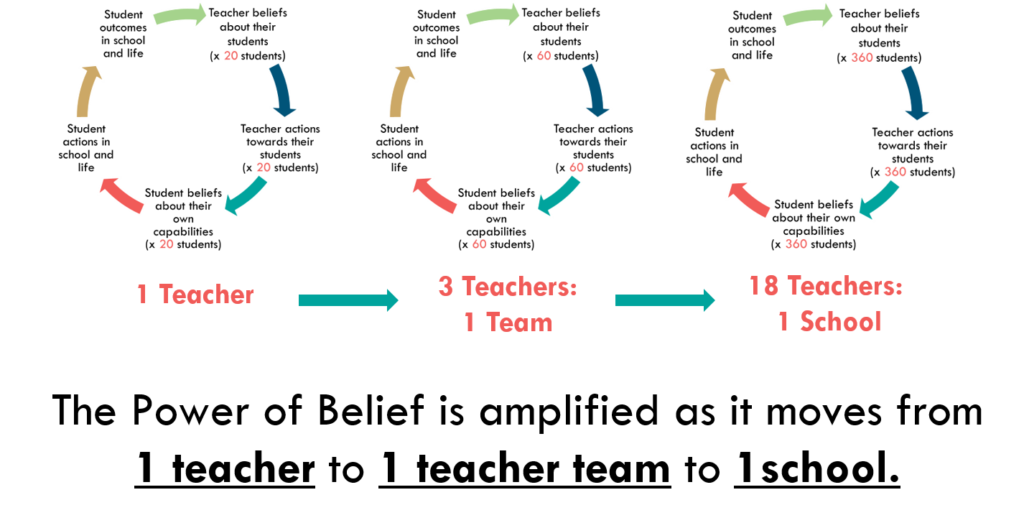UNPACKING ESSENTIAL FUNCTION 2: BUILDING SOCIAL NETWORKS AND ENHANCING COLLABORATION
“What we think, we become.”
(Budda n.d.)
Pygmalion Effect – Belief Influences Efficacy
The Pygmalion Effect is a form of self-fulfilling prophecy. It is a phenomenon whereby another’s expectations of a person affect that person’s performance (Center for Teaching Excellence, n.d.). In 1968, Rosenthal and Jacobsen told teachers that certain students had extremely high IQ scores even though they actually spanned a typical range from low to high. In response, the teachers spent more time with the students they believed were “smarter,” gave them more challenging assignments, and expected more from them. As a result, the students who were perceived as “smarter” ultimately scored significantly higher. This research highlights how positive and negative expectations influence teacher actions.
Strong social networks and collaboration in schools create a context that increases expectations of both individual teachers and teams through feedback and encouragement (social persuasion), which can lead to increased teacher self-efficacy and CTE. When a school staff shares a belief that they can positively impact student learning, success can be exponentially impacted throughout the school. The graphic below illustrates the rate in which positive CTE can impact expectations for students and lead to greater student achievement.

School Leaders as Architects of Social Networks
Change is dependent on relationships within a system. Teacher social networks provide opportunities for teachers to turn to colleagues for advice regarding instruction; facilitate quicker and more efficient sharing of resources and knowledge; and provide more opportunities for verbal persuasion and vicarious experience. School leaders are in a position to encourage the development of teacher networks and provide opportunities to connect educators in a variety of ways with the purpose of increasing their knowledge about each other’s work and their effective use of evidence-based practices (Donohoo, 2017). In a study that examined school social networks in 20 middle school mathematics departments across 3 years, Berebitsky & Salloum (2017) found the density of teacher networks was positively and significantly related to levels of collective efficacy. Schools with more dense social networks had higher levels of CTE. To promote change, school leaders can consider strategies to purposefully connect teachers with one another.
Social Networks in Practice
Watch the video Time Matters: Teacher Collaboration for Learning and Leading (StandfordSCOPE, 2018).
Time Matters: Teacher Collaboration for Learning and Leading (13:46 min.)
Reflection Questions
- List the benefits of allotting and prioritizing time for collaboration.
- What examples of CTE do you see in this video?
- As a leader who wishes to be an architect of change, consider how you might encourage the building of social networks in your school.
- Determine which people or groups are isolated and identify ways to encourage greater interactions with those who are committed to the school culture.
- What policies or practices support the building of social networks? How might these be enhanced?
- What policies or practices hinder the building of social networks? How can these obstacles be overcome?
- How could technology be used more effectively to build social networks?
As you work to build and enhance social networks within your school, keep in mind that effective teacher collaboration should focus on improving instructional practice. Encourage the following with teachers.
- Collaborate formally and informally to discuss data both horizontally and vertically
- Share knowledge and resources of high-impact practices, formally and informally
- Observe one another to provide opportunities to discuss instruction
- Have high expectations for themselves and students
- Celebrate successes and challenge negativity
Social Networks and Collaboration that build CTE look like…
- A variety of organizational structures (e.g. teams, committees, professional development opportunities) available for staff participation
- Membership in groups is linear rather than all groups being hierarchical
- Teachers sharing knowledge and ideas freely and with a variety of colleagues
- Teachers having the opportunity to talk to other colleagues every day
- Teachers having multiple, safe avenues for giving and receiving advice and feedback
Reflection Questions
- How do educator beliefs impact student outcomes throughout a school?
- How can the collaborative structures currently in place be improved or enhanced?
- What action steps can be taken to initiate new strategies for improving collaboration and making it more inclusive and productive?

